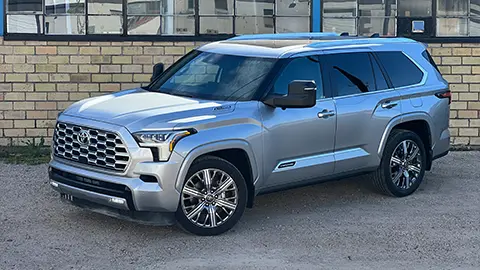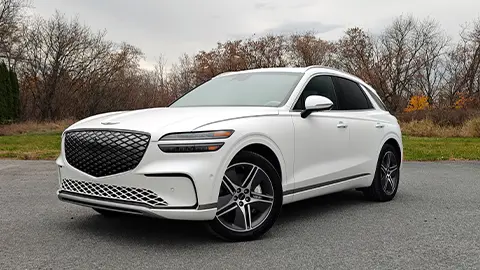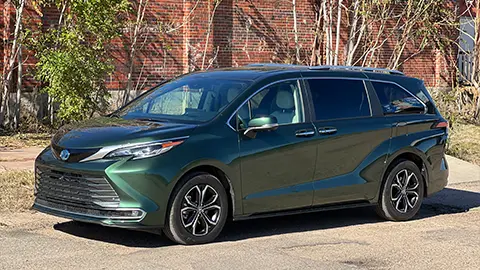2024 Ford Escape PHEV
Curiously, if you look at the “electric” section of Ford’s main consumer site, you won’t find the 2024 Escape plug-in hybrid – only the Mustang Mach-E, F-150 Lightning, and the E-Transit work van. Sure, there’s a less prominent “electrified” section in its vehicles section, where you’ll find those plus the Escape plug-in hybrid that I drove for a week – as well as a regular hybrid version of the Escape (look, ma, no plug).
As one of six trims of Ford’s popular compact Escape crossover, the Plug-in Hybrid (PHEV) sits at the top of the Escape’s price and efficiency scale – and it provides decent value, if not heaps of driving- or adventure-ready excitement. Key features like all-wheel drive are not part of the PHEV’s options list, while a relatively tame engine leaves it well behind other Escape models, as well as most compact plug-in hybrid rivals, on the performance front as well.

Escape Hybrid History: Now a Value PHEV Player
Ford’s first-generation Escape offered a hybrid option from 2005 to 2014, but in much of the 2010s, it was left to Ford’s now-discontinued C-Max Hybrid and C-Max Energi PHEVs to be the company’s highly touted direct rivals for the Toyota Prius hatchback and its plug-in version.
The fourth-generation Escape that debuted in 2020 brought about the return of an Escape Hybrid, while the plug-in hybrid version arrived about a year later. This plug-in hybrid compact SUV was a rival to more recent PHEV variants of the Toyota RAV4, Dodge Hornet, Hyundai Tucson and Jeep Wrangler. It was freshened for the 2023 model year inside and out, as seen on this tester, with the only changes for 2024 being the deletion of the B-pillar keyless entry keypad option, as well as just one year of connected navigation – as opposed to three years previously.
At a starting MSRP of $41,995, the Escape PHEV is priced near the bottom of this class, so it offers a lot of value overall, especially considering that it, and the much pricier Wrangler 4xe PHEVs are, the only ones of this group currently to qualify for federal rebates of $3,750 to buyers.
Keep in mind, though, that the full $7,500 incentive may be available for consumers willing to lease any of these plug-in vehicles – no matter whether they qualify for the $3,750 or not – and these eligible vehicle lists can (and will) change frequently, so you’ll want to double-check the plug-in rebate status of any vehicles you’re interested in often at the EPA’s tax incentive site here.

Ford Escape PHEV Design and Interior
The refreshed styling of the Escape PHEV includes the obligatory-for-the-class lower body cladding, providing visual adventurousness and useful rock chip protection. Upper trims offer an increasingly-popular LED strip between the front headlights that provides an arguably more modern face at night than during the day, while the overall silhouette is inoffensively modern but not particularly memorable.
Inside it’s a similar story, with a usefully-large 13.2-inch center screen and a fully digital 12.3-inch digital instrument panel that can be adjusted to show a wide range of information tailored to the driver’s preferences, plus a rotary shifter – all of which creates a modern feel inside without many artistic or design flourishes.
There’s a healthy dollop of standard features on the Escape PHEV, including intelligent keyfob access, remote start, wireless Apple CarPlay and Android Auto, first and second-row dual USB-A and -C power points, a powered tailgate, plus a heated steering wheel and front seats. The excellent SiriusXM 360L system allows more stations than regular satellite radio programming allowed before, and also comes standard, though like Ford’s Connected services, will also require a subscription after a set time.
This fully-loaded Escape PHEV version also included niceties inside that mostly come as part of the model’s large and somewhat pricey ($4,530) Premium package, which includes a 360-degree camera with front and rear washers (especially handy in slushy winters), dual power seats, front parking sensors, a head-up display (HUD), 10-speaker Bang & Olufsen sound system, quilted leather seats with memory function, rain-sensing wipers, and a wireless phone charging pad, among others.
There were also a couple of à la carte options, including an opening panoramic roof, and a handy trailer tow package rated to 3,500 pounds – impressive as some plug-in hybrid vehicles are not rated to tow at all. Fully kitted out like this, the as-tested price of my Escape PHEV came in at $49,465, before taxes or government rebates.
Practicality-wise, space is very good up front and in the rear seat, with enough headroom in all five seats for six-foot folks. There’s six inches of adjustment in the rear seat that allows for some extra cargo room flexibility, but both the hybrid and PHEV versions of the Escape lose about three feet of cubic feet of space compared to regular versions, with a second row in this tester that didn’t fold very flat.
The powered tailgate is also a nice upgrade compared to other rivals that either don’t offer it as standard – or at all– though the foot-operated activation didn’t work as reliably as it does in my older C-Max Energi.
Class-Leading Efficiency and Electric Range
Looking at its EPA figures, the Escape PHEV is the most fuel-efficient in the class once its all-electric miles are used up, averaging a combined 40 mpg. This is likely because most of its rivals offer all- or four-wheel drive as standard equipment, while the Escape PHEV is basically the only version of the Escape not to offer an all-wheel drive option. That’s a major turn-off for some compact SUV buyers, no matter how much it helps fuel efficiency.
The Escape PHEV’s all-electric range of 37 miles* is behind the RAV4 Prime’s 42 miles*, but ahead of rivals like the new Dodge Hornet PHEV and Hyundai Tucson plug-in hybrid. It’s also worth noting here that these larger batteries can also hold more of the energy regenerated than regular hybrids – therefore increasing the potential distance traveled in EV mode beyond these stated maximums per charge. If you spend a lot of time in heavy urban driving, plug-in hybrids shine brightest, and you may see even better results.
Where the Escape PHEV doesn’t shine brightest is when it comes to power. Its 2.5-litre Atkinson cycle four-cylinder engine, with electric assistance, produces 210 hp and 155 lb-ft of torque, which is right at the pack of this PHEV pack. Its continuously variable transmission, with no shift paddles, doesn’t help best extract this power either.

Smooth PHEV Performance
This lack of power may be glaring on the road, but even more glaring is the contrast of how loud the engine is, once you lose the smooth, silent operation that electric power provides. The EV power provides a lovely Cinderella effect, but once you’ve run out of juice, the Escape PHEV becomes rougher and less refined. It almost lashes you to smooth out your inputs, control your urge for sudden acceleration, and enjoy electric cruise mode for as long as possible – and to try and find Level 2 charging stations when you’re out and about.
There’s no DC fast-charging capability on the Escape PHEV to quicken up a charge either, which is only the usual J1772 connection available; charging up this Escape takes roughly 3.5 hours on a Level 2 charger. A trickle charge on a normal 110-volt outlet takes about 10.5 hours, predicts Ford, though these will all be longer in chillier garages over the winter. In this class, not having DC charging capability is common, but the larger Mitsubishi Outlander PHEV offers 50 kW DC quick-charging as standard, along with a third row, for roughly the same starting price.
The Escape PHEV’s overall driving personality is clearly more comfort-oriented than anything else, and even with winter tires the ride seemed well-controlled but not harsh. There’s little temptation to push hard either in corners or on straights, as this Ford is most impressive when it stays in its EV mode as long as possible.
Ford Escape PHEV: The Verdict
Since the regular hybrid Escape only costs about $2,000 less than this Escape PHEV’s $40,500 starting price, there’s a worthy value equation for those looking to minimize fuel costs as much as possible, while maximizing quietly luxurious all-electric driving. Sadly the Escape PHEV model will only be available at EV-certified Ford stores – which is roughly half of Ford’s U.S. dealers as of early 2024, so if you really want one, you may wish to check online first which of your local Ford dealers carries them.
The major tell will be that it has Mustang Mach-Es on the lot, as most of Ford’s other electrified models look very similar to the their gas counterparts. And if you’re looking at a top-line Ford Escape PHEV at about $50k that’s most impressive during its 37 miles* of electric driving, you may want to consider the Mach-E as a more modern and faster alternative that can travel 250 mile*s in this mode – and also deliver all-wheel drive as well.
*All mileage is EPA-estimated
















